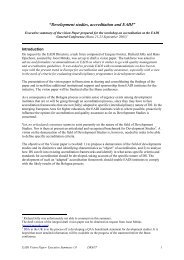Revenue Administration in Sub-Saharan Africa - International Tax ...
Revenue Administration in Sub-Saharan Africa - International Tax ...
Revenue Administration in Sub-Saharan Africa - International Tax ...
Create successful ePaper yourself
Turn your PDF publications into a flip-book with our unique Google optimized e-Paper software.
Box 6: The common characteristics of large taxpayers• Large taxpayers are very different from other categories of taxpayers andpresent certa<strong>in</strong> significant risks to effective tax adm<strong>in</strong>istration. Many revenuebodies have recognized that manag<strong>in</strong>g these risks requires strategies andapproaches appropriate to the unique characteristics and compliancebehaviour of these taxpayers. Key characteristics of the large bus<strong>in</strong>esstaxpayer segment <strong>in</strong>clude:• Concentration of revenue – a small number of large taxpayers have a criticalrole <strong>in</strong> revenue collection, pay<strong>in</strong>g and withhold<strong>in</strong>g taxes. The concentration oftax revenue results from the pure size of these taxpayers and the range oftaxes they are responsible for, <strong>in</strong>clud<strong>in</strong>g their role as withhold<strong>in</strong>g agents forlarge numbers of employees.• Complexity of their bus<strong>in</strong>ess and tax deal<strong>in</strong>gs – several countries describelarge taxpayers as complex for a variety of reasons, <strong>in</strong>clud<strong>in</strong>g: (1) multipleoperat<strong>in</strong>g entities and/or diverse bus<strong>in</strong>ess <strong>in</strong>terests; (2) high volume oftransactions <strong>in</strong> day-to-day bus<strong>in</strong>ess activities; (3) large number of employees;(4) many have <strong>in</strong>ternational deal<strong>in</strong>gs, often <strong>in</strong>volv<strong>in</strong>g cross-border transactionswith related parties; (5) operate <strong>in</strong> an <strong>in</strong>dustry that presents unique tax issues(e.g. bank<strong>in</strong>g and <strong>in</strong>surance); (6) many are widely spread <strong>in</strong> geographical terms;(7) deal with complicated issues <strong>in</strong>volv<strong>in</strong>g complex tax law and account<strong>in</strong>gpr<strong>in</strong>ciples; and (8) use complex f<strong>in</strong>anc<strong>in</strong>g and tax plann<strong>in</strong>g arrangements.• From the revenue bodies’ perspective, major tax compliance risks – forrevenue bodies, many of these large taxpayers present major tax compliancerisks due to various factors <strong>in</strong>clud<strong>in</strong>g: (1) significant offshore activities; (2)policies and strategies to m<strong>in</strong>imize tax liabilities; (3) large portion of taxassessments result from audit activity of large taxpayers; and (4)grow<strong>in</strong>g/significant differences between f<strong>in</strong>ancial account<strong>in</strong>g profits and theprofits computed for tax purposes.• Withhold<strong>in</strong>g agent or <strong>in</strong>termediary role – As well as pay<strong>in</strong>g taxes, largetaxpayers also play a significant <strong>in</strong>termediary‘ role <strong>in</strong> many tax systemscollect<strong>in</strong>g taxes <strong>in</strong>clud<strong>in</strong>g: (1) personal or employee <strong>in</strong>come tax withhold<strong>in</strong>gsand social contributions, and VAT; and (2) withhold<strong>in</strong>g tax on certa<strong>in</strong> crossborder payments such as dividends, royalties and <strong>in</strong>terest.• Use of professional/dedicated tax advice – many large bus<strong>in</strong>esses and high<strong>in</strong>come<strong>in</strong>dividuals reta<strong>in</strong> professional advisors to handle their tax plann<strong>in</strong>gand compliance affairs while others ma<strong>in</strong>ta<strong>in</strong> their own <strong>in</strong>-house taxorganization.• Status - generally, most large bus<strong>in</strong>esses are publicly-listed corporatecompanies, and also <strong>in</strong>clude mult<strong>in</strong>ational companies and some privategroups.Source: OECD (2009)34





